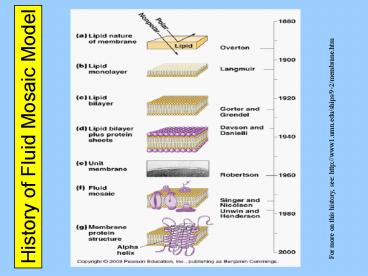History of Fluid Mosaic Model - PowerPoint PPT Presentation
1 / 43
Title:
History of Fluid Mosaic Model
Description:
Lipid bilayers are fluid, at normal body (organismal) ... Protein-Mediated Catalysis without getting bogged down in the details of Chemical Reactions! ... – PowerPoint PPT presentation
Number of Views:1127
Avg rating:3.0/5.0
Title: History of Fluid Mosaic Model
1
History of Fluid Mosaic Model
For more on this history, see http//www1.umn.edu
/ships/9-2/membrane.htm
2
PhospholipidsLipid Bilayar
3
Membrane Fluidity
Lipid bilayers are fluid, at normal body
(organismal) temperatures, but typically only in
two dimensions!
4
Membrane Proteins
5
Membrane Protein Functions
6
Membrane Assymetry
This asymmetry allows the cell to automatically
differ its intracellular environment from that
existing extracellularly
7
Membrane Glycoproteins
8
Fluid Mosaic Model
9
Movement Across Membranes
Passive Transport Simple diffusion (passive
diffusion) Facilitated diffusion Transporters
Uniporters Cotransporters Channel
proteins Active Transport Pumps Group
Translocation Electrochemical Gradients
10
Movement Across Membranes
Passive Transport Simple diffusion (passive
diffusion) Facilitated diffusion Transporters
Uniporters Cotransporters Channel
proteins Active Transport Pumps Group
Translocation Electrochemical Gradients
11
Primer on Diffusion
- Diffusion is movement from area of high
concentration to low - Diffusion is Passive Transport no energy is
required
12
Simple Diffusion Across Bilayers
- Passive diffusion
- - unaided by transport proteins
- - no metabolic energy expended
- - movement is down chemical concentration
gradient - - diffusion rate is proportional to
concentration gradient and hydrophobicity - - rate limiting step is movement across
hydrophobic portion of membrane - - the greater the hydrophobicity of a
water-soluble molecule, the faster it diffuses
across phospholipid bilayer.
13
Simple Diffusion Across Bilayers
14
Diffusion Across Membranes
15
Osmosis H20 Down Conc. Gradient
16
Osmosis H20 Down Conc. Gradient
17
Tonicity H20 Down Conc. Gradient
18
Movement Across Membranes
Passive Transport Simple diffusion (passive
diffusion) Facilitated diffusion Transporters
Uniporters Cotransporters Channel
proteins Active Transport Pumps Group
Translocation Electrochemical Gradients
19
Protein-Mediated Diffusion
20
Proteins Involved in Membrane Transport
- Transport of molecules and ions across the cell
membrane is mediated by transport proteins - - integral (intrinsic) membrane proteins
(transmembrane contain multiple transmembrane a
helices). - - Peripheral (extrinsic) membrane proteins
(examples spectrin and actin in RBC protein
Kinase C)
It is Integral Membrane Proteins that are
involved in Membrane Transport
21
Membrane Transport Proteins
- All are integral membrane proteins
- All exhibit high degree of specificity for
substance transported - Three major classes
- ATP powered pumps- ATPases that use energy of
ATP hydrolysis to move ions or small molecules
across membrane against a chemical
concentration gradient or electrical potential
active transport - Channel proteins form water filled pores
across the bilayer through which ions move down
their concentration or electrical potential
gradients at rapid rates - Transporters bind only specific substrate
molecule at a time (binding of substrate
induces conformational change) - -if transported molecule crosses membrane
passively then downhill process called passive
transport or facilitated diffusion
22
Uniporters and Cotransporters
We can divide Transporters into two distinct
types
- Uniporters
- move one molecule at a time down a
concentration gradient
- Symporter or Antiporter (cotransporters)
- couple movement of one or more ions down their
concentration gradient with movement of another
ion or molecule against its concentration
gradient - former is passive transport latter is active
transport
23
Uniporter Catalized Transport
- Uniporters enable amino acids, nucleosides, and
sugars to enter and leave cells down their
concentration gradients - Accelerate a reaction that is already
thermodynamically favored - Facilitated transport (or facilitated diffusion)
- - accelerated rate
- - like enzyme-mediated catalysis, transport is
stereospecific (ie. D-glucose) - - transport occurs via limited number of
uniporter molecules
24
Uniporter Voltage-Gated Channel
25
Movement Across Membranes
Passive Transport Simple diffusion (passive
diffusion) Facilitated diffusion Transporters
Uniporters Cotransporters Channel
proteins Active Transport Pumps Group
Translocation Electrochemical Gradients
26
Active Transport
Active transport requires energy to move
substances from areas of lower concentration to
areas of higher concentration
27
Sodium-Potassium Pump
In addition to their intrinsic relevance,
studying Membrane-Transport Proteins allows us to
appreciate Mechanisms of Protein-Mediated
Catalysis without getting bogged down in the
details of Chemical Reactions!
28
Electrochemical Gradient
- An Electrochemical Gradient is a Concentration
Gradient with Ions - - These ions want to move down their
concentration gradient - - These ions (particularly) also want to move
towards the opposite charge found on the other
side of the membrane - - This attraction for the other side of
membranes (membrane potential) can be harnessed
to do work - - Electrochemical gradients essentially are
batteries, i.e., means of physically storing
electrical energy
29
Membrane Potential
30
Proton Pump
Proton pumps are used by plants, bacteria, and
fungi to create electrochemical gradients
(sodium-potassium pumps are employed by animals
for the same purpose)
31
Cotranport as Active Transport
32
Cotransport Catalized Transport
Net equation for two Na / one-glucose
symporter 2Na out glucose out ? 2Na in
glucose in
14 membrane-spanning ? helices
33
Uniporter Facilitated Diffusion
Note that phosphorylation of glucose inside of
cell drives this transport, making it an example
Group Translocation
34
Movement Across Membranes
Movement Across Membranes
Passive Transport Simple diffusion (passive
diffusion) Facilitated diffusion Transporters
Uniporters Cotransporters Channel
proteins Active Transport Pumps Group
Translocation Electrochemical Gradients
35
Movement Across Membranes
Movement Across Membranes
Endocytosis Phagocytosis Pinocytosis Receptor
mediated Exocytosis These are mechanisms that
involve movement into and out of the lumen of the
endomembrane system Not movement directly across
membranes
36
Endocytosis
Note that the substance enters the Endomembrane
System but not the Cytoplasm
37
Phagocytosis
38
Pinocytosis
39
Endocytosis Receptor Mediated
40
Endocytosis Receptor Mediated
41
Exocytosis
42
Link to Next Presentation
43
Acknowledgements
www.uiowa.edu/c156201/PDFLecs/Schmidt/Schmidt01.p
pt www.avs.uidaho.edu/Rod20Class20Notes/AVS221-B
iol21220-20Topic203-2.ppt bio.winona.edu/wilson
/cell20biology/924.ppt biology.ucf.edu/courses/b
sc2010/08-2010C-02.PPT www.floyd.edu/ddaugherty/10
10/membrane.ppt www.biosci.ohiou.edu/courses/2002
03/ fall/bios/103schutte/chap03n.ppt
www.aw.com/bc/ppt/marieb_ap/chap03c.ppt































